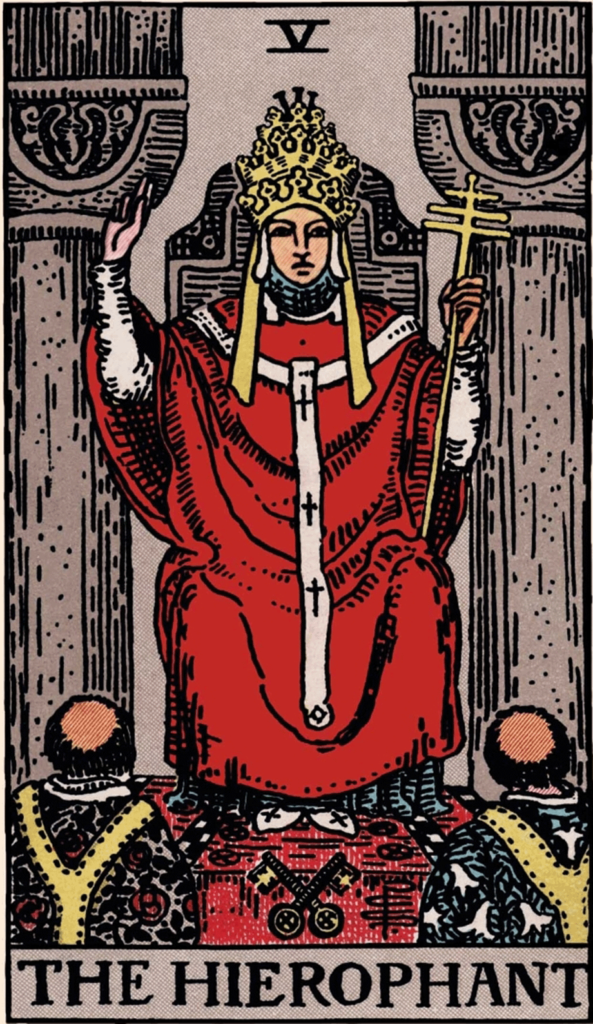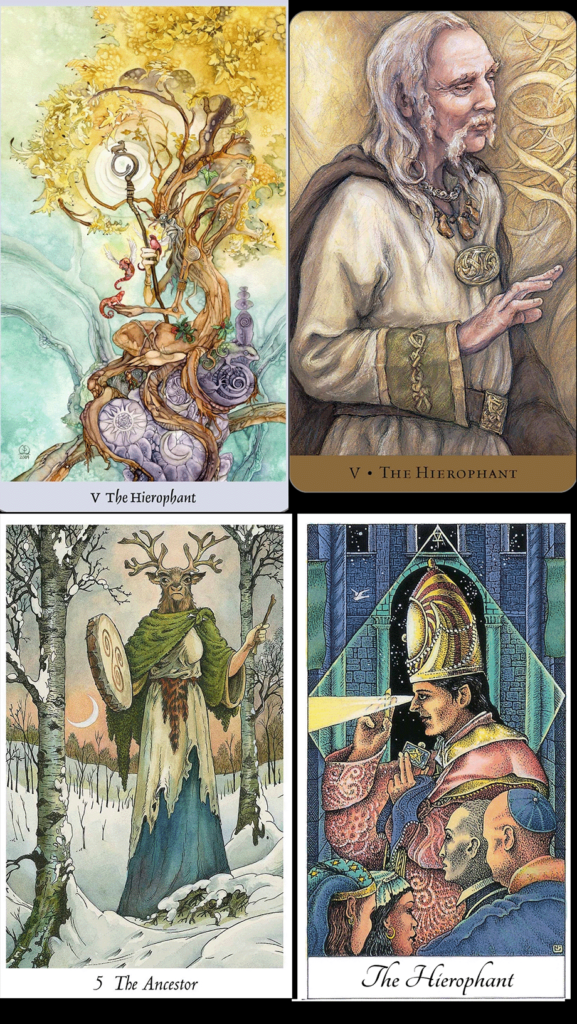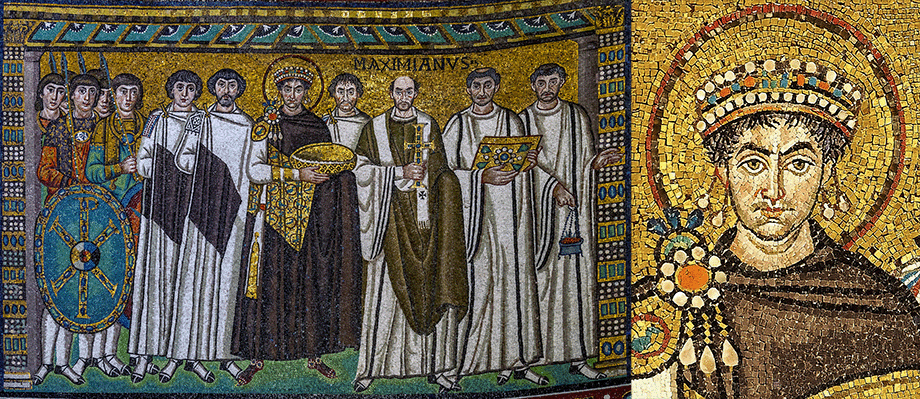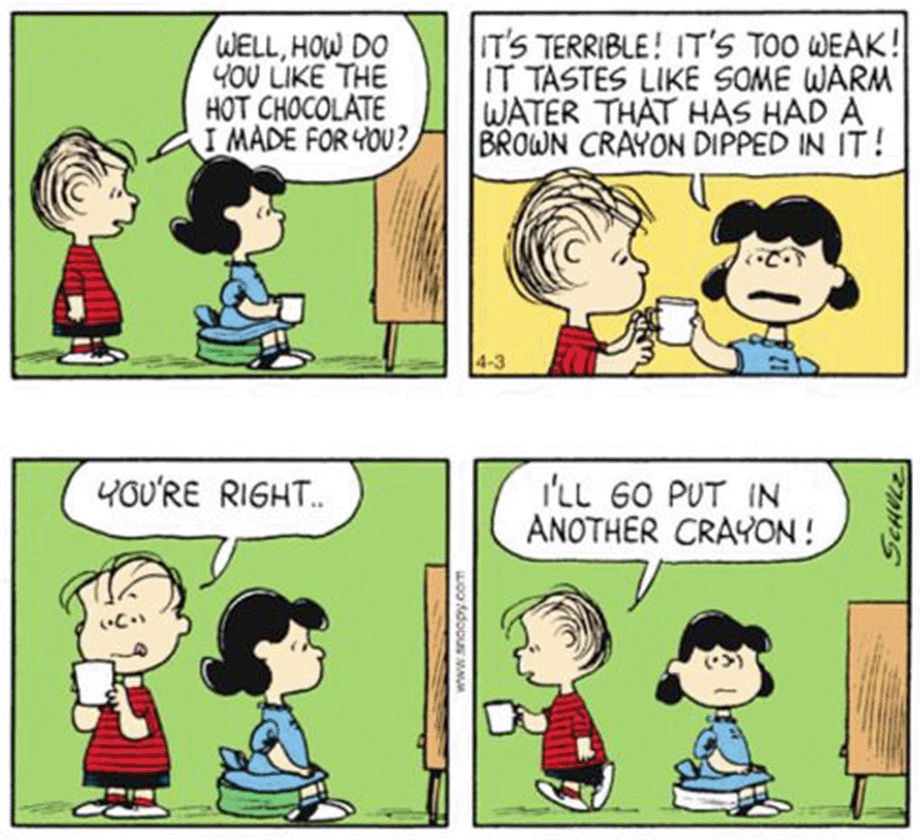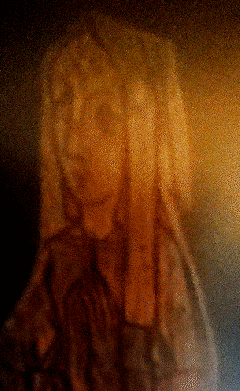The card called the Lovers is another one very problematic in terms of the imagery used in the RWS deck. The elder versions of this card depict three persons at the bottom, and the demi-god Cupid or Eros overhead with his bow. Much speculation has been made about the identity of the people on this version of the card, but from my view it tends to suggest a young man and woman being married. The other figure is probably his mother, who up to that point has been the “woman in his life”. Cupid/Eros, of course, is interested in the conjugal love, rather than the familial or maternal sort, and the arrow pointed between the pair that appear to be getting betrothed argues for that. So the Lovers is a fair name for the card as it was drawn up to the end of the 19th century, with the Marriage being a close runner-up.
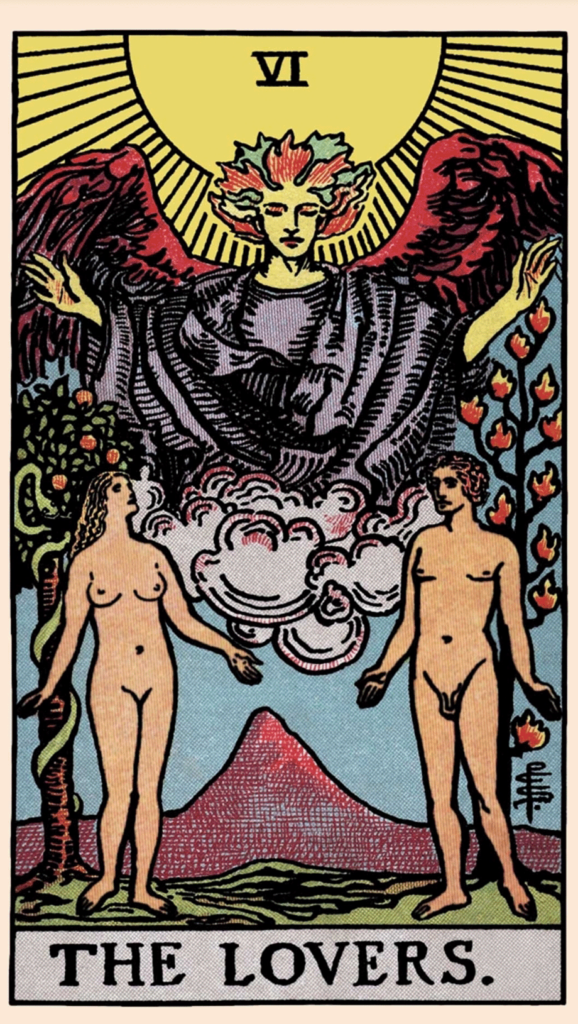
There seems little logic then, in dumping this traditional structure for a wholly Judeo-Christian depiction straight out of the Book of Genesis, but that is what Waite apparently commissioned. The card number VI has only three figures, a female and male, both nude, and a flaming haired angel appearing out of a cloud above them. These figures are unquestionably Eve and Adam, for they stand in front of two trees. Eve is before a fruit tree with a green snake wrapped around it. This is undoubtedly the Tree of the Knowledge of Good and Evil, and the Biblical downfall of Man, tempted by Woman, who was tempted by the Serpent to eat of the tree. Behind Adam is a tree with flames instead of leaves. This is identified by Waite in his Pictorial Key to the Tarot as the Tree of Life, but it’s a clear reference to the Burning Bush of Exodus. Between the two, and below the angel, is a single pointed mountain. Above and behind the angel is a yellow radiance. Below the angel is a simple blue sky.
Like the Hierophant card that proceeds it, my initial reaction to this Biblical imagery was negative. Here again my inclination to reject the Christian world that I had been born into (for multiple reasons not entirely related to magic or the occult) made me feel like the Tarot cards that I had been fascinated by in textbook descriptions were somehow subverted back toward a Christian idea.

I cannot say that this is not absolutely true at least in the mind of Arthur Waite, and many of his contemporaries, who were possibly trying to meld together their monotheism with pagan magic rites. While it’s clear that some of those involved in the magic lodges of the Victorian era and their 20th centuries inheritors were bored elites looking for sensation, a good number of them never really wanted to reject the “respectable C of E” religion.
And again, because Pamela Smith’s art is so ubiquitous, we are all of us still carrying the images around, even in many of the revisions and re-imaginings of modern Tarot, because this version has had such an impact on the 20th century occult in the West.
The Golden Dawn and other influencers on Waite were romanticists. That is, they tended to think in idealistic or utopian terms rather than the crude, and sometimes cruel realities of the time. Their motivations were informed by the ancient philosophers, seeking truth and beauty, and deifying these ideas separately from how they exist (or don’t exist) in the mundane world.
So the rather direct depiction of love and lovers in the physical carnal sense, was less than satisfactory. While certainly most of these folk were frequently involved in such sensual pursuits, many quite outside the socially accepted norms of the day, they made a public face of a much loftier ideal and that is what we find on the seventh card of the Major Arcana.
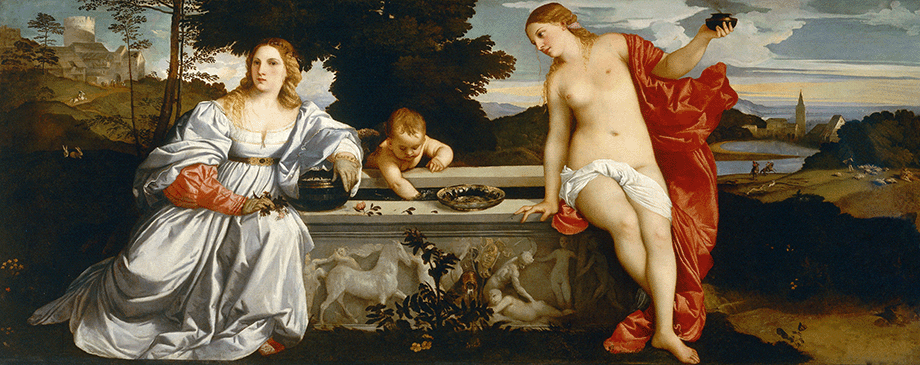
That the painting is allegorical is unquestionable. What exactly the allegory is supposed to be is up to interpretation. Over the years it has come to be called “Sacred and Profane Love”. When I was a student the sacred one was on the right, because the one fully dressed may be considered to be “of the material world” and thus “profane” in the older sense of the word.
It may be helpful at this point to examine a painting by Titian usually titled “Sacred and Profane Love”. This painting itself has invited much controversy in the art historical circles, and presents us with a similar conundrum as the Smith version of the Lovers. Yet if we examine its symbolism, we may find some keys to unlock the Biblical facade of the Lovers card.
When I was in art history class, some many years ago, the conventional attribution of “sacred love” was actually the nude figure, and not the severely overdressed one. Conventions are now reversed, but I never pay much attention to trends, and still tend to think of it that way. I have some sound reasoning for that.
There’s a confusion in our modern language because we have come to use the term “profane” in the sense of “profanity”. In our post-Puritanical society profanity is in the same category with smut and pornography, and of course, “nekkid people” are associated with carnal desires.
Profane, originally, was only meant as the opposite of sacred. Sacred derives from old Latin and means basically “Holy”. Ergo, whatever was not holy, was, by extension, profane. It had nothing to do with the particular state of dress, it had to do with a state of being.
There are variant descriptions of Titian’s painting as Earthly and Heavenly Love, or as the Earthly and Heavenly Venus, and this may clear it up a little for people struggling with the changes in the language. The nude is the rarified pure spirit, with none of the trappings we attach to bring it down to earth. While it may represent a carnal satisfaction, it also symbolizes that expansion of mind and being that results from the merging of two souls.
The Earthly Venus has her charms, and these are of course symbolized by her fancy robes and complicated hairstyle and rich jewels. These are the things of the mundane, however. They shift with fashion, whim, and time, whereas the Heavenly Sacred Love is immortal, untouched and timeless.
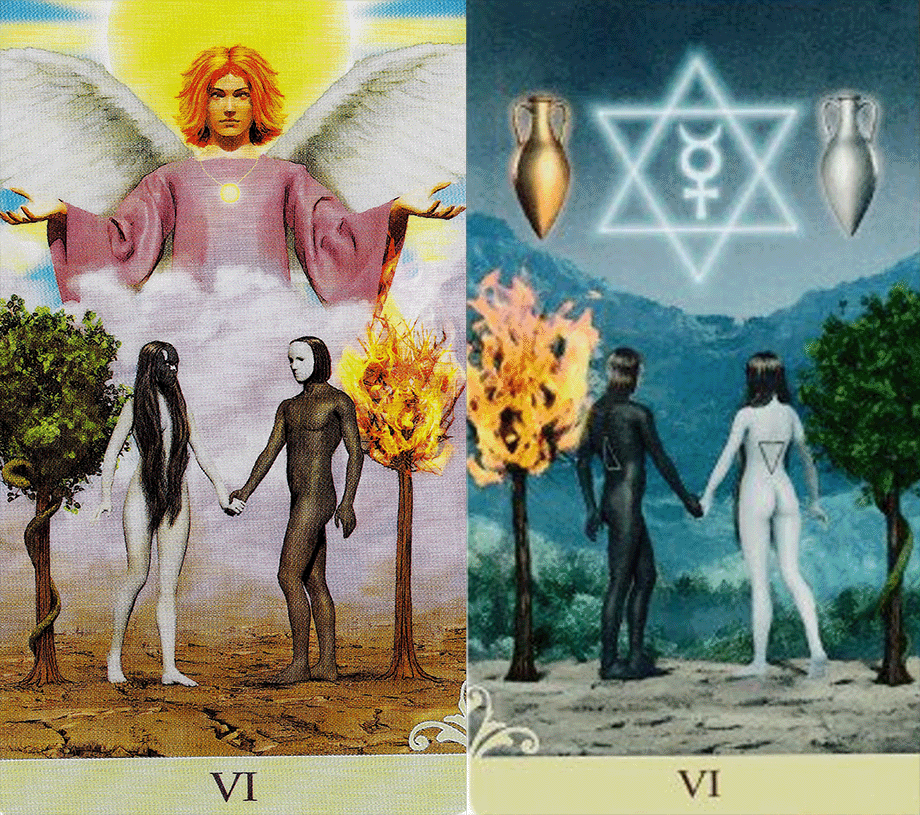
It is this notion of Sacred Love which later generations have tried to apply to Waite’s ham-handed vision of Eden. This is Man and Woman, before the Fall, perfect, immortal, without sin or the knowledge of sin, and therefore without the need for carnal connection, long identified in Puritanical teaching as the “original sin”. The angel between them can be seen as symbolic of this perfected state of innocence, a bliss that requires no physicality, but is that highest form of love.
But, well, I think there may be a worm or two in that apple.
The Genesis story is one of those things that started to break any bond I might have formed with the Christian faith at an early age. The presence here of the Serpent in the tree shows us that the Fall (per the Bible) is imminent. It is inevitable. It is all part of the Divine Plan, after all, that an all-seeing and all-knowing being saw and knew about before any of it happened but it was allowed to happen anyway because that was the Divine Plan.
Honestly I have a much easier time reconciling Shroedinger’s cat than I do the sales pitch for these religions.
“Look, Adam, Eve, here’s this absolutely beautiful Garden I made for you. You have total control over everything in it. And you can eat everything, except for the fruit on this tree.”
“Why?”
“Because you can’t.”
“Why?”
“Look, I know you are going to eat the fruit, but don’t eat the fruit.”
“Why?”
“Because there’s this skeezy dude who is going to come around later and tell you to eat the fruit, and I know you’re going to eat the fruit, but don’t eat the fruit.”
“Why?”
“JUST DON”T EAT THE FRUIT ( even though I know you’re gonna) DON’T EAT IT!”
And then the next day:
“YOU ATE THE FRUIT! I mean, I knew – I KNEW – you were gonna eat the fruit, but you actually ate the fruit! I am so disappointed and angry and so now you have to leave the Garden and spend your days in war and pestilence and famine and death.”
“Why?”
“Divine Plan!”
This is essentially what Waite tells us this card means in his Pictorial Guide to the Tarot. The Lovers, in his “remediation” is symbolic of the Lord God Jehovah allowing (if not causing) the Fall, so that eons later mankind can be redeemed by the Messiah,
So Lovers may be more accurately rendered Love, and by that the love of the deity toward “his” creation, which manifests itself as predestined suffering and torment.
But Lovers was kept because only through that perfect love of the deity, could humanity transcend the carnal sin inherent in sexual relationships that they were going to get into in order to “be fruitful and multiply” as that deity keeps telling them to do (usually after destroying vast swathes of humanity in a fit of pique).
Even at age seven I saw the holes in that, although I can’t say as I fully articulated the whole divine love thing (and had not even a vague notion of carnal sin). So I tried to find other ways to interpret this card.

A lot of the Major Arcana (and some of the Minors) have a capacity to be overlapped. The relationship between the Lovers and the Devil is fairly obvious, but the positioning of the humans (assuming the people on XV are fallen humans) can also be overlain with the Pillars which the Priestess sits between. This again gives us the doctrine of opposite points, with a mediator or medium between, which leads us to a more complex view of the whole.
Here we can connect up Eve and the Tree of Knowledge with Boaz, which we’ve rendered as “that which is mutable”. Adam and the Tree of Life comes under the dominion of Jachin or “that which is established”. This gives us the opportunity to look at the central portion of the card as a portal.
This is the largest part of the image anyway and it’s dominated by the figure of the Angel. In fact, there’s an axis defined through the Angel from the peak of the mountain, through to the center of the radiance above it’s head. The Angel holds a hand over either figure, partaking of both natures. The dual colors used in the hair of the Angel reflect the green of the Tree of Knowledge and the flaming orange of the Tree of Life. The Angel is our pathway between the mundane world (even if it’s Eden) and that’s which is beyond.
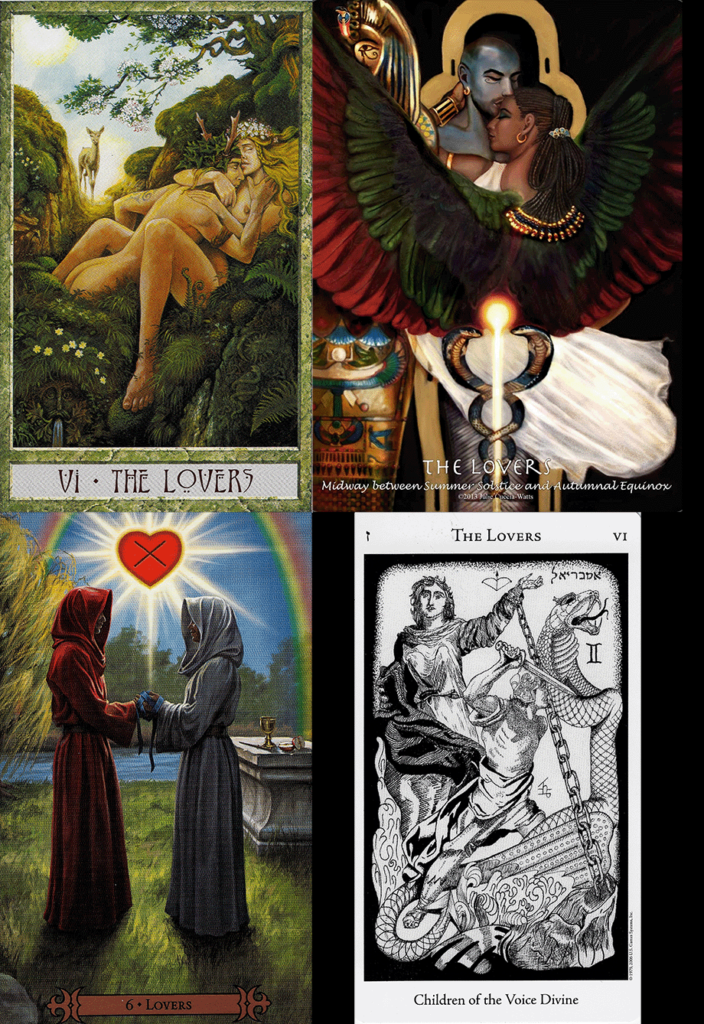
The Druid Craft Tarot by Phillip Carr-Gorm and illustrated by Will Worthington offer us a pagan variant that celebrates the human experience. The spirit is there, still, in the form of the doe and the Green Man.
The Journey Into Egypt Tarot by Julie Cuccia-Watts depicts the love of Isis for the Dead Osiris. While embracing the Egyptian myth, it manages to incorporate many of the elements of Pixie Smith’s version, and presents us with another layer of mysteries to explore.
The Hermetic Tarot by Godfrey Dowson is based on the teachings of the Order of the Golden Dawn. It is not, however, the Golden Dawn Tarot. In this rendition the serpent story is remade as that of Perseus rescuing Andromeda.
The Modern SpellCasters Tarot by Melanie Marquis with art by Scott Murphy offers something more along the lines of a modern pagan hand-fasting. The references from Genesis have completely disappeared and in their place is symbolism and paraphernalia from Wicca or a similar practice.
The layout here is similar to many depictions in alchemical texts of the “Chymical Wedding”. This Hermetic rebus is supposed to provide the adept with multiple formulae for creating the Elixir of Life and/or Philosopher’s stone. The allegories typically include hermaphrodites, or merged male/female figures, often connected with the sun and moon. Numerous other symbols adorn the landscapes they inhabit. All of these form a secret code known to students of alchemy.
This card then can give us an insight into transcendence and infinity, not through a Judeo-Christian “Divine Plan” but through our own transmutation, Love, both spiritual and corporeal, is a key to our self-awareness. We are spirits in a physical body. Denial of either nature will ultimately lead to our being “expelled from the garden”. If we limit our perspectives, we stall our spiritual growth. We are, after all, given the Knowledge of Good and Evil.
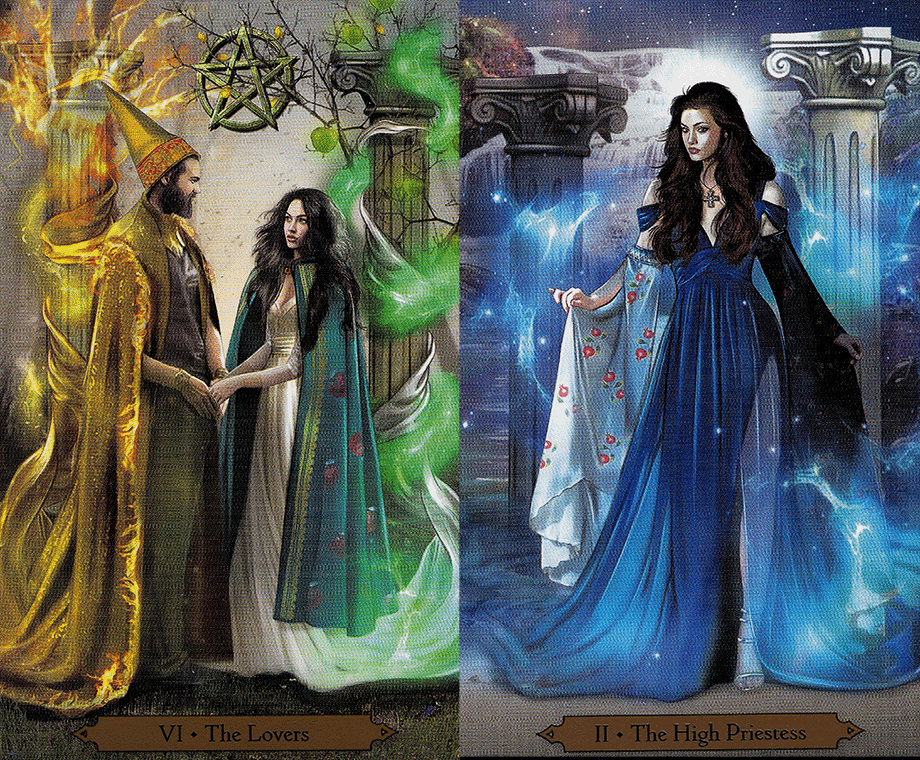
I have always personally felt that the tale of the Fall in Genesis was an allegory of the evolution of man. While this seems fairly straightforward in today’s scientifically leaning world, consider what an idea this is in the 16th century, before Darwin.
The story says that human beings, prior to eating of the Tree of Knowledge, lived in a paradise, running naked among the other animals. When they ate the fruit of the Tree, they became aware of their nakedness and covered themselves. This is not merely an expression of late Renaissance modesty. It’s establishing why we humans feel the need to cover up, when our kin among the chimps and bonobos continue to run around in the altogether.
In reality, of course, the “nakedness” of humanity is an expression of our self-awareness. As “dumb animals” we aren’t separate from the rest of nature, but when we evolved to self-awareness, we gained the knowledge of our otherness. We divorce ourselves from that nature. We left the garden.
So in this set of images, we have reinforcement of the idea of transmutation, or evolution, or our own spiritual growth and expression. When we find it in a reading or use it in meditation or magic, these meanings can be employed to route around the overt or at least apparent, Judeo-Christian iconography that Waite “corrected” from the original images of the Middle Ages.
Once we free ourselves from these conventions, we can proceed to the rest of the Major Arcana with a wider perspective and a fresh eye. We’ll assay the Chariot next week, though the interelatedness of many of these cards means we’ll probably refer back to the Lovers again, sooner and later.
I hope you have found this exercise to be revealing. I have found this card to be difficult over the years because of it’s baggage. If you want to consider it, as many do, just on the basis of the name, it can signify romance, relationships, and sex. But it also carries a link to Gemini, and can be read with regard to contracts, mergers, and legal pleadings, as well as relationships with zero romantic or sexual aspects.
Until next week, I thank you for your continued patronage.



